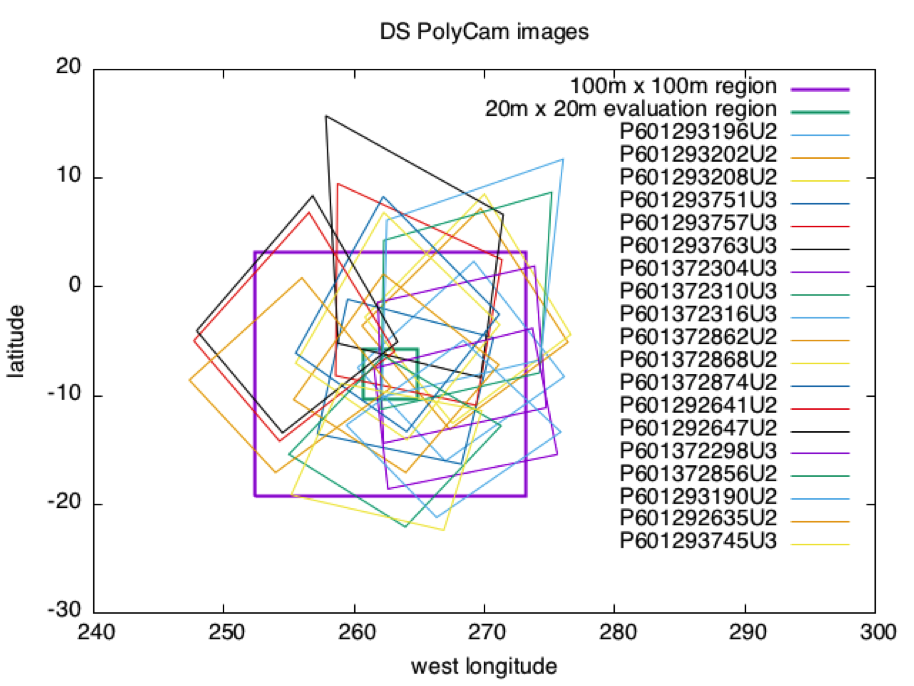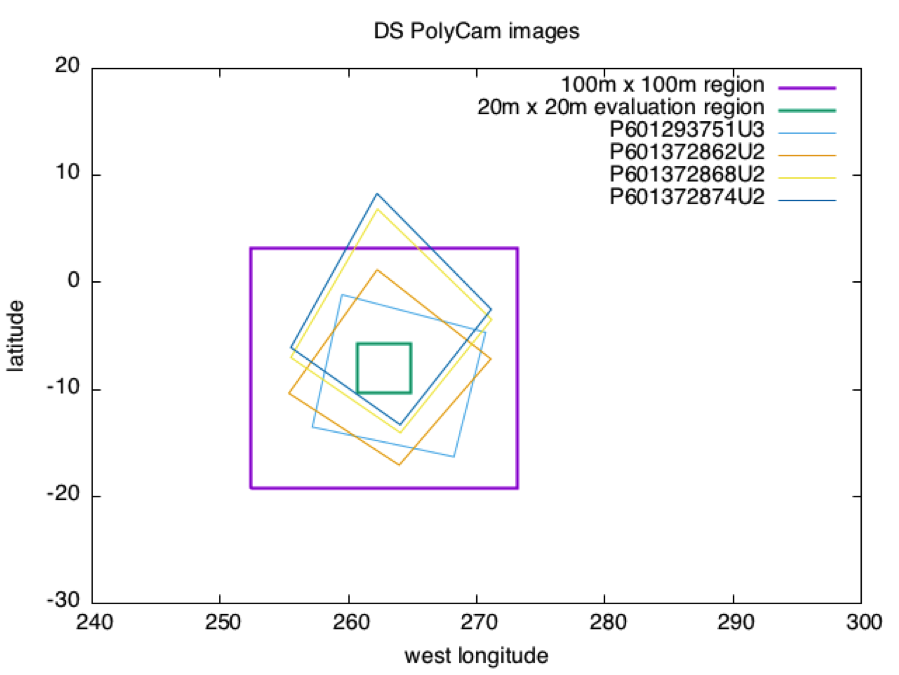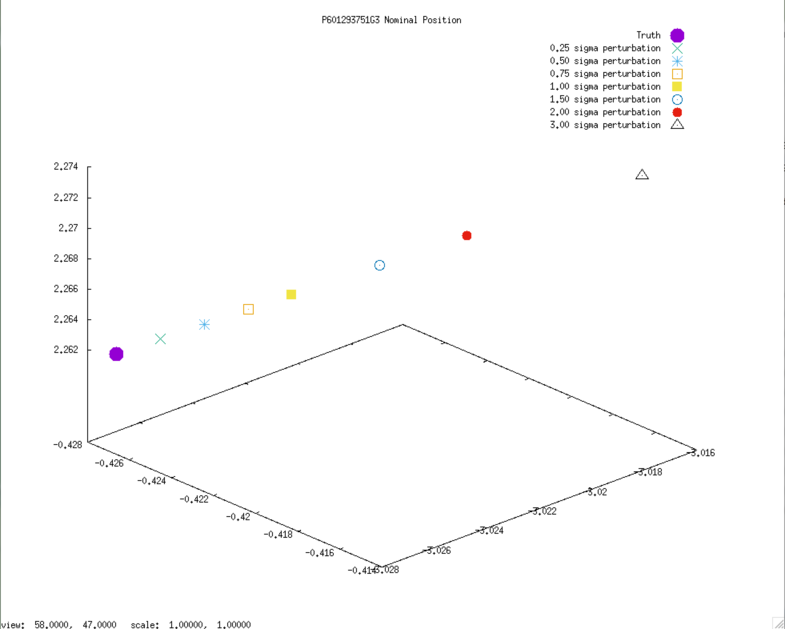|
Size: 1525
Comment:
|
Size: 6231
Comment:
|
| Deletions are marked like this. | Additions are marked like this. |
| Line 2: | Line 2: |
== Definitions == '''CompareOBJ RMS:''' The root mean square of the distance from each bigmap pixel/line location to the nearest facet of the truth OBJ.<<BR>> '''PTG:''' The formal camera pointing uncertainty.<<BR>> '''SCOBJ:''' The S/C position vector from the center of the asteroid.<<BR>> '''VSO:''' The formal SCOBJ uncertainty.<<BR>> == Additional Tests == === S/C position and pointing uncertainties === The Detailed Survey PolyCam F3G data set had large S/C position and pointing uncertainties, unsuitable for Detailed Survey Baseball Diamond trajectories: * VSO = 1km; * PTG = 1mrad. An additional suite of tests was therefore run with a duplicate Detailed Survey PolyCam dataset with S/C position and pointing uncertainties set to one-sigma: * VSO = 6.4m; * PTG = 0.217mrad. Results for both data sets are presented herein. === Model shift === In the process of generating the 35cm Preliminary Shape Model a shift in the body center with respect to the inertial center occurred. The magnitude of the shift was approximately 2m. Since the final S/C position across F3G subtests lay in a region 2m to 8m from the true S/C position, the effect of the body center shift came into question. To investigate, an alternative 35cm Preliminary Shape Model with no body-center shift was generated. One subtest was re-run using the alternative start model. == Key Findings == The results show no significant difference in the final S/C position (SCOBJ) and model accuracy (as measured with CompareOBJ RMS) with respect to the magnitude of S/C position and pointing perturbation within the ranges tested, indicating that the SPC-driven modeling is immune to S/C position and pointing perturbation up to three standard deviations. It should be noted that S/C position perturbation was divided equally between the SCOBJ components, resulting in a distance from the truth position which was a multiple of the standard deviation of 6.4m. Therefore: * maximum lateral perturbation was a multiple of 3.7m (6.4m/sqrt(3)); * maximum normal perturbation (wrt body center) was 3.7m (6.4m/sqrt(3)). It is assumed that the worst case scenario is a 3 x sigma (19.2m) lateral perturbation. The maximum possible lateral perturbation tested was 3 x 3.7m = 11.1m. In all cases, the final SPC-derived S/C position is within 8m of the true S/C position, but in only two cases is within 2m of the true S/C position. The actual distance from the true S/C position is not dependent on the initial perturbed position - for example in the 0.25 x sigma case, the SPC-derived S/C position (distance from truth: 1.6m to 6.9m) in most cases moves further away from the true S/C position than its initial position (distance from truth: 1.6m). The final SPC-derived S/C positions appear to be clustered around an incorrect solution 2m-8m distant from the true S/C position. |
|
| Line 5: | Line 42: |
| The CompareOBJ RMS (for the final 5cm resolution 20m x 20m evaluation bigmap) does not appear to be affected by the magnitude of S/C position and pointing perturbation within the ranges tested. CompareOBJ RMSs differ slightly with S/C position and camera pointing uncertainties, approx. 5cm difference for CompareOBJ RMS without translation/rotation, approx. 2cm difference for CompareOBJ RMS with optimal translation and rotation. The CompareOBJ optimal translation routine is not optimized for the evaluation model scale (5cm pix/line resolution). Manual translations of the bigmap were therefore conducted in an attempt to find a minimum CompareOBJ RMS. The manually translated evaluation models gave the smallest CompareOBJ RMSs. |
|
| Line 6: | Line 49: |
'''CompareOBJ Optimal Translations:''' ||'''Sub-Test'''||'''Perturbation Magnitude'''||||||'''Translation (cm)'''|| ||F3G7||0.25 x sigma||85.0698||62.3596||-14.3765|| ||F3G6||0.50 x sigma||84.5538||61.6624||-15.3434|| ||F3G5||0.75 x sigma||95.8438||59.9313||-21.6901|| ||F3G3||1.00 x sigma||106.4870||58.2162||-27.3527|| ||F3G4||1.50 x sigma||79.1224||63.2865||-19.6432|| ||F3G2||2.00 x sigma||110.1339||58.9454||-23.2403|| ||F3G1||3.00 x sigma||93.5937||61.6997||-26.8422|| |
|
| Line 9: | Line 62: |
| The first graph shows footprints for all Detailed Survey PolyCam images which were included in the model. The second graph shows the four images down-selected due to their coverage of the 20m x 20m evaluation region, and their almost complete containment within the iterated 100m x 100m region. | The first graph shows footprints for all Detailed Survey PolyCam pictures which were included in the model. The second graph shows the four pictures down-selected due to their coverage of the 20m x 20m evaluation region, and their almost complete containment within the iterated 100m x 100m region. |
| Line 17: | Line 70: |
| Distance magnitude is plotted for the full Detailed Survey PolyCam image set. 3D graphs of final SCOBJ and truth is then plotted for each image. The first four are the down-selected evaluation images, the rest of the set is included for comparison. | The distance of the final SPC-derived S/C position from the true S/C position is plotted for the full Detailed Survey PolyCam image set for each magnitude of perturbation. The evaluation images are plotted in red. 3D graphs of final SPC-derived SCOBJ and true SCOBJ are then plotted for each picture. The first four are the down-selected evaluation pictures, the rest of the image set is included for comparison. The pattern of final SPC-derived SCOBJ is broadly consistent across magnitudes of perturbation. The position correction is mostly a normal correction with lateral movement, bringing the modeled S/C position within an approx. 8m-radius sphere around the true position (or, in the case of perturbations<8m, pushing SCOBJ outwards up to 8m). |
| Line 23: | Line 80: |
| '''Example nominal SCOBJs:''' |
|
| Line 24: | Line 83: |
''' Final solution SCOBJs:''' |
TestF3G - Results
Definitions
CompareOBJ RMS: The root mean square of the distance from each bigmap pixel/line location to the nearest facet of the truth OBJ.
PTG: The formal camera pointing uncertainty.
SCOBJ: The S/C position vector from the center of the asteroid.
VSO: The formal SCOBJ uncertainty.
Additional Tests
S/C position and pointing uncertainties
The Detailed Survey PolyCam F3G data set had large S/C position and pointing uncertainties, unsuitable for Detailed Survey Baseball Diamond trajectories:
- VSO = 1km;
- PTG = 1mrad.
An additional suite of tests was therefore run with a duplicate Detailed Survey PolyCam dataset with S/C position and pointing uncertainties set to one-sigma:
- VSO = 6.4m;
- PTG = 0.217mrad.
Results for both data sets are presented herein.
Model shift
In the process of generating the 35cm Preliminary Shape Model a shift in the body center with respect to the inertial center occurred. The magnitude of the shift was approximately 2m. Since the final S/C position across F3G subtests lay in a region 2m to 8m from the true S/C position, the effect of the body center shift came into question. To investigate, an alternative 35cm Preliminary Shape Model with no body-center shift was generated. One subtest was re-run using the alternative start model.
Key Findings
The results show no significant difference in the final S/C position (SCOBJ) and model accuracy (as measured with CompareOBJ RMS) with respect to the magnitude of S/C position and pointing perturbation within the ranges tested, indicating that the SPC-driven modeling is immune to S/C position and pointing perturbation up to three standard deviations.
It should be noted that S/C position perturbation was divided equally between the SCOBJ components, resulting in a distance from the truth position which was a multiple of the standard deviation of 6.4m. Therefore:
- maximum lateral perturbation was a multiple of 3.7m (6.4m/sqrt(3));
- maximum normal perturbation (wrt body center) was 3.7m (6.4m/sqrt(3)).
It is assumed that the worst case scenario is a 3 x sigma (19.2m) lateral perturbation. The maximum possible lateral perturbation tested was 3 x 3.7m = 11.1m.
In all cases, the final SPC-derived S/C position is within 8m of the true S/C position, but in only two cases is within 2m of the true S/C position. The actual distance from the true S/C position is not dependent on the initial perturbed position - for example in the 0.25 x sigma case, the SPC-derived S/C position (distance from truth: 1.6m to 6.9m) in most cases moves further away from the true S/C position than its initial position (distance from truth: 1.6m).
The final SPC-derived S/C positions appear to be clustered around an incorrect solution 2m-8m distant from the true S/C position.
CompareOBJ RMS
The CompareOBJ RMS (for the final 5cm resolution 20m x 20m evaluation bigmap) does not appear to be affected by the magnitude of S/C position and pointing perturbation within the ranges tested.
CompareOBJ RMSs differ slightly with S/C position and camera pointing uncertainties, approx. 5cm difference for CompareOBJ RMS without translation/rotation, approx. 2cm difference for CompareOBJ RMS with optimal translation and rotation.
The CompareOBJ optimal translation routine is not optimized for the evaluation model scale (5cm pix/line resolution). Manual translations of the bigmap were therefore conducted in an attempt to find a minimum CompareOBJ RMS. The manually translated evaluation models gave the smallest CompareOBJ RMSs.
CompareOBJ Optimal Translations:
Sub-Test |
Perturbation Magnitude |
Translation (cm) |
||
0.25 x sigma |
85.0698 |
62.3596 |
-14.3765 |
|
0.50 x sigma |
84.5538 |
61.6624 |
-15.3434 |
|
0.75 x sigma |
95.8438 |
59.9313 |
-21.6901 |
|
1.00 x sigma |
106.4870 |
58.2162 |
-27.3527 |
|
1.50 x sigma |
79.1224 |
63.2865 |
-19.6432 |
|
2.00 x sigma |
110.1339 |
58.9454 |
-23.2403 |
|
3.00 x sigma |
93.5937 |
61.6997 |
-26.8422 |
|
Image Footprints
The first graph shows footprints for all Detailed Survey PolyCam pictures which were included in the model. The second graph shows the four pictures down-selected due to their coverage of the 20m x 20m evaluation region, and their almost complete containment within the iterated 100m x 100m region.


Distance SCOBJ(truth) to SCOBJ(solution)
The distance of the final SPC-derived S/C position from the true S/C position is plotted for the full Detailed Survey PolyCam image set for each magnitude of perturbation. The evaluation images are plotted in red.
3D graphs of final SPC-derived SCOBJ and true SCOBJ are then plotted for each picture. The first four are the down-selected evaluation pictures, the rest of the image set is included for comparison.
The pattern of final SPC-derived SCOBJ is broadly consistent across magnitudes of perturbation. The position correction is mostly a normal correction with lateral movement, bringing the modeled S/C position within an approx. 8m-radius sphere around the true position (or, in the case of perturbations<8m, pushing SCOBJ outwards up to 8m).
Evaluation Pictures
Example nominal SCOBJs:

Final solution SCOBJs:
